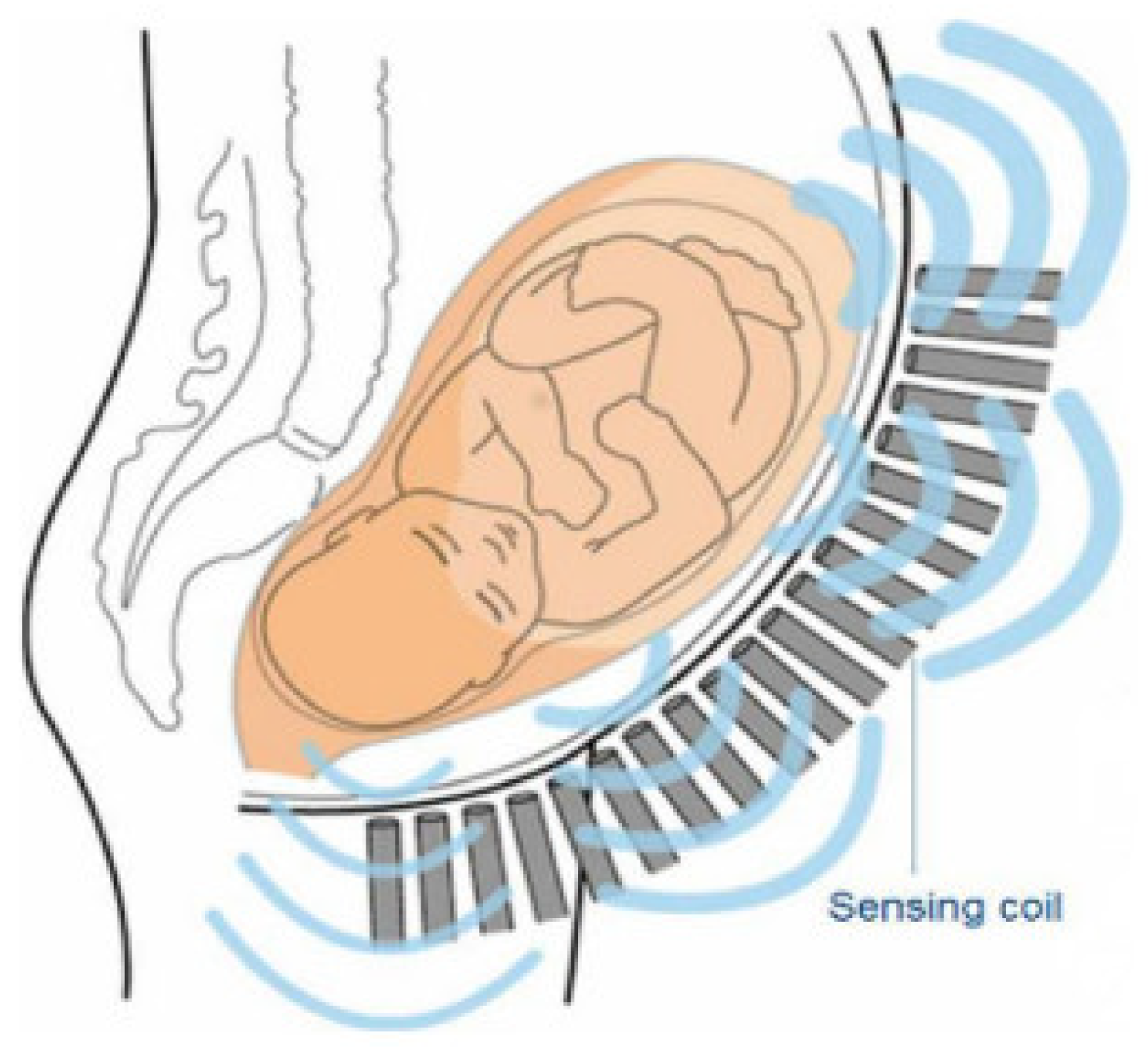Bio-Magneto Sensing and Unsupervised Deep Multiresolution Analysis for Labor Predictions in Term and Preterm Pregnancies †
Abstract
:1. Introduction
2. Materials and Methods
2.1. Materials
2.2. Methods
2.2.1. DWS
2.2.2. Linear Series Decomposition Learner (LSDL)
2.2.3. Handcrafted Features and Machine Learning Models
3. Results
4. Conclusions
Author Contributions
Funding
Institutional Review Board Statement
Informed Consent Statement
Data Availability Statement
Acknowledgments
Conflicts of Interest
References
- Nsugbe, E. A Cybernetic Framework for Predicting Preterm and Enhancing Care Strategies: A Review. Biomed. Eng. Adv. 2021, 2, 100024. [Google Scholar] [CrossRef]
- World Health Organization Preterm Birth. Available online: https://www.who.int/news-room/fact-sheets/detail/preterm-birth (accessed on 25 August 2022).
- Nsugbe, E.; Obajemu, O.; Samuel, O.W.; Sanusi, I. Enhancing Care Strategies for Preterm Pregnancies by Using a Prediction Machine to Aid Clinical Care Decisions. Mach. Learn. Appl. 2021, 6, 100110. [Google Scholar] [CrossRef]
- Nsugbe, E.; Obajemu, O.; Samuel, O.W.; Sanusi, I. Application of Noninvasive Magnetomyography in Labour Imminency Prediction for Term and Preterm Pregnancies and Ethnicity Specific Labour Prediction. Mach. Learn. Appl. 2021, 5, 100066. [Google Scholar] [CrossRef]
- Eswaran, H.; Preissl, H.; Wilson, J.D.; Murphy, P.; Lowery, C.L. Prediction of Labor in Term and Preterm Pregnancies Using Non-Invasive Magnetomyographic Recordings of Uterine Contractions. Am. J. Obstet. Gynecol. 2004, 190, 1598–1602; discussion 1602–1603. [Google Scholar] [CrossRef] [PubMed]
- Babu, T.A.; Kumar, D. Features Extraction and Classification of Uterine Magnetomyography Signals. Int. J. Curr. Eng. Sci. Res. 2018, 5. [Google Scholar]
- Nsugbe, E.; Sanusi, I. Towards an Affordable Magnetomyography Instrumentation and Low Model Complexity Approach for Labour Imminency Prediction Using a Novel Multiresolution Analysis. Appl. AI Lett. 2021, 2, e34. [Google Scholar] [CrossRef]
- Andén, J.; Mallat, S. Deep Scattering Spectrum. IEEE Trans. Signal Process. 2014, 62, 4114–4128. [Google Scholar] [CrossRef]
- Escalona-Vargas, D.; Govindan, R.B.; Furdea, A.; Murphy, P.; Lowery, C.L.; Eswaran, H. MMG Database 2016.
- Zhang, M.; Rosa, P.S.L.; Eswaran, H.; Nehorai, A. Estimating Uterine Source Current during Contractions Using Magnetomyography Measurements. PLoS ONE 2018, 13, e0202184. [Google Scholar] [CrossRef] [PubMed]
- Nsugbe, E.; Starr, A.; Ruiz-Carcel, C. Monitoring the Particle Size Distribution of a Powder Mixing Process with Acoustic Emissions: A Review. Eng. Technol. Ref 2016, 1–12. [Google Scholar] [CrossRef]
- Nsugbe, E. Particle Size Distribution Estimation of a Powder Agglomeration Process Using Acoustic Emissions. Ph.D. Thesis, Cranfield University, Cranfield, UK, 2017. [Google Scholar]
- Nsugbe, E.; Starr, A.; Jennions, I.; Ruiz-Carcel, C. Estimation of Online Particle Size Distribution of a Particle Mixture in Free Fall with Acoustic Emission. Part. Sci. Technol. 2019, 37, 953–963. [Google Scholar] [CrossRef]
- Nsugbe, E.; Williams Samuel, O.; Asogbon, M.G.; Li, G. Contrast of Multi-Resolution Analysis Approach to Transhumeral Phantom Motion Decoding. CAAI Trans. Intell. Technol. 2021, 6, 360–375. [Google Scholar] [CrossRef]
- Nsugbe, E.; Ser, H.-L.; Ong, H.-F.; Ming, L.C.; Goh, K.-W.; Goh, B.-H.; Lee, W.-L. On an Affordable Approach towards the Diagnosis and Care for Prostate Cancer Patients Using Urine, FTIR and Prediction Machines. Diagnostics 2022, 12, 2099. [Google Scholar] [CrossRef] [PubMed]
- Nsugbe, E.; Connelly, S. Multiscale Depth of Anaesthesia Prediction for Surgery Using Frontal Cortex Electroencephalography. Healthc. Technol. Lett. 2022, 9, 43–53. [Google Scholar] [CrossRef] [PubMed]
- Nsugbe, E. On the Application of Metaheuristics and Deep Wavelet Scattering Decompositions for the Prediction of Adolescent Psychosis Using EEG Brain Wave Signals. Digit. Technol. Res. Appl. 2022, 1, 9–24. [Google Scholar] [CrossRef]
- Nsugbe, E.; Phillips, C.; Fraser, M.; McIntosh, J. Gesture Recognition for Transhumeral Prosthesis Control Using EMG and NIR. IET Cyber-Syst. Robot. 2020, 2, 122–131. [Google Scholar] [CrossRef]

| Method | Accuracy (%) | Merits | Demerits | Reference |
|---|---|---|---|---|
| DWS | 62.7 |
|
| Present study |
| LSDL + Handcrafted Features | 90 |
|
| [7] |
| Handcrafted Features Only | 70 |
|
| [7] |
Disclaimer/Publisher’s Note: The statements, opinions and data contained in all publications are solely those of the individual author(s) and contributor(s) and not of MDPI and/or the editor(s). MDPI and/or the editor(s) disclaim responsibility for any injury to people or property resulting from any ideas, methods, instructions or products referred to in the content. |
© 2023 by the authors. Licensee MDPI, Basel, Switzerland. This article is an open access article distributed under the terms and conditions of the Creative Commons Attribution (CC BY) license (https://creativecommons.org/licenses/by/4.0/).
Share and Cite
Nsugbe, E.; Samuel, O.W.; Reyes-Lagos, J.J.; Adams, D.; Obajemu, O. Bio-Magneto Sensing and Unsupervised Deep Multiresolution Analysis for Labor Predictions in Term and Preterm Pregnancies. Eng. Proc. 2023, 58, 125. https://doi.org/10.3390/ecsa-10-16245
Nsugbe E, Samuel OW, Reyes-Lagos JJ, Adams D, Obajemu O. Bio-Magneto Sensing and Unsupervised Deep Multiresolution Analysis for Labor Predictions in Term and Preterm Pregnancies. Engineering Proceedings. 2023; 58(1):125. https://doi.org/10.3390/ecsa-10-16245
Chicago/Turabian StyleNsugbe, Ejay, Oluwarotimi Williams Samuel, Jose Javier Reyes-Lagos, Dawn Adams, and Olusayo Obajemu. 2023. "Bio-Magneto Sensing and Unsupervised Deep Multiresolution Analysis for Labor Predictions in Term and Preterm Pregnancies" Engineering Proceedings 58, no. 1: 125. https://doi.org/10.3390/ecsa-10-16245
APA StyleNsugbe, E., Samuel, O. W., Reyes-Lagos, J. J., Adams, D., & Obajemu, O. (2023). Bio-Magneto Sensing and Unsupervised Deep Multiresolution Analysis for Labor Predictions in Term and Preterm Pregnancies. Engineering Proceedings, 58(1), 125. https://doi.org/10.3390/ecsa-10-16245






